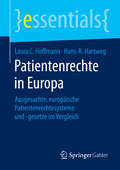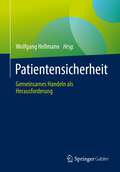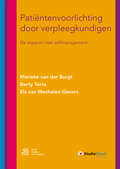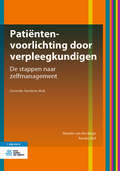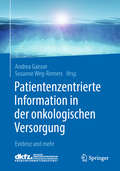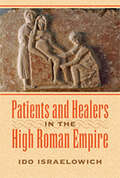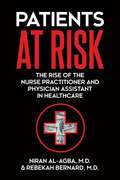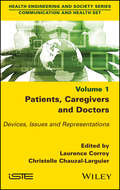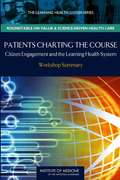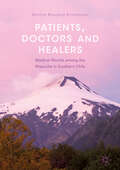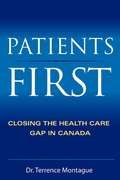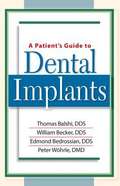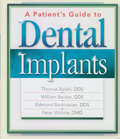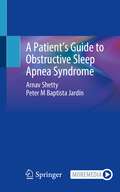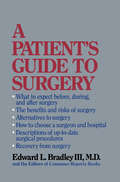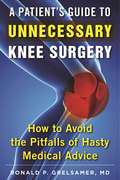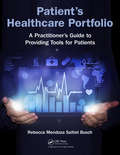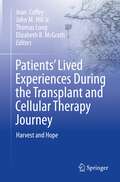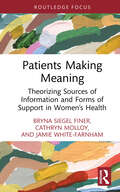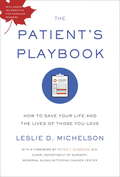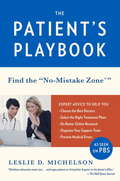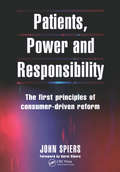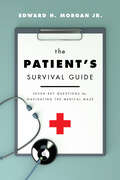- Table View
- List View
Patientenrechte in Europa: Ausgesuchte, europäische Patientenrechtesysteme und -gesetze im Vergleich (essentials)
by Hans-R. Hartweg Laura C. HoffmannLaura C. Hoffmann und Hans-R. Hartweg stellen auf Basis der Regelwerke ausgesuchter europäischer Nationen Vergleiche an, wie dort zum Schutz von Patientinnen und Patienten agiert wird. Nachdem in Deutschland das Patientenrechtegesetz verabschiedet wurde, das im Wesentlichen Patienten-Ansprüche in einer Rechtsgrundlage zusammenführt, ist eine Diskussion entbrannt, ob dieses Gesetz nicht eventuell zu kurz greift. Es kann dabei sinnvoll sein, den Blick auch über internationale Regeln schweifen zu lassen und einen Fokus auf Systeme zu legen, die auf historische oder institutionelle Entwicklungsverläufe schauen, die dem deutschen Gesundheitssystem ähneln. In einigen Nachbarstaaten sind entsprechende Patientenansprüche bereits tief verwurzelt und die Bürgerinnen und Bürger schauen auf eine lange Tradition entsprechender Regelwerke zurück.
Patientensicherheit: Gemeinsames Handeln als Herausforderung
by Wolfgang HellmannPatientensicherheit wird – auch im Kontext von Krisen wie Corona – zum beherrschenden Thema für die notwendige Neupositionierung des Gesundheitswesens in Deutschland. Dieses Buch setzt bei der Analyse der Rahmenbedingungen an und fokussiert auf einen ganzheitlichen Ansatz von Patientensicherheit unter Beteiligung von Versorgern, Vertretern der Gesundheitspolitik, der Ärzteschaft und den Krankenkassen, aber auch unter Einbindung von Patienten und Angehörigen. Es werden neue Versorgungskonzepte, innovative Managementstrategien sowie zielführende Instrumente zur Gewährleistung hoher Versorgungsqualität und Patientensicherheit vorgestellt. Zahlreiche Handlungsoptionen, Praxistipps und Fallbeispiele stellen den Praxisbezug zur Umsetzung insbesondere für die Ärzteschaft her. Ein Glossar mit wichtigen Begriffen, vor allem zur Information von Patienten und Personal der Versorgungseinrichtungen, rundet das Buch ab.
Patiëntenvoorlichting door verpleegkundigen
by Berty Terra Marieke van der Burgt Els van Mechelen-GeversVan patiënten wordt steeds meer zelfmanagement verwacht. Maar als verpleegkundige interventie is patiëntenvoorlichting en ondersteuning van zelfmanagement vaak weinig concreet uitgewerkt. Patiëntenvoorlichting door verpleegkundigen. De stappen naar zelfmanagement biedt hulp.Ondersteuning van zelfmanagement wordt steeds belangrijker voor de verpleegkundige en de praktijkondersteuner in de huisartsenpraktijk. Samenwerking en gezamenlijke besluitvorming vormen de basis voor daarvoor. De in dit boek geïntroduceerde praktische stappenreeks van gedragsverandering (openstaan - begrijpen - willen - kunnen - doen - blijven doen) bevordert een methodische aanpak bij de voorlichting en ondersteuning van zelfmanagement bij persoonsgerichte zorg. Nieuw in deze herziene uitgave is de nadruk op ondersteuning van zelfmanagement van chronisch zieken op basis van het zogeheten chronischezorgmodel. Daarnaast is er aandacht voor voorlichting aan mensen met beperkte taal- en informatievaardigheden en bevat het boek video's van voorlichtings- en ondersteuningsgesprekken. Tot slot bevat het boek toegepaste theorie met voorbeelden uit de verpleegkundige praktijk. Dit boek is bestemd voor studenten verpleegkunde (hbo-v), studenten verpleegkundige vervolgopleiding, verpleegkundigen, praktijkondersteuners, nurse practitioners, verpleegkundig specialisten. Marieke van der Burgt is docent aan de opleiding verpleegkunde van het Rijn IJssel in Arnhem, publicist en trainer patiëntenvoorlichting. Berty Terra heeft een jarenlange ervaring als docent psychologie/agogiek en trainer patiëntenvoorlichting en gespreksvaardigheden aan Fontys Hogeschool Eindhoven. Els van Mechelen-Gevers heeft een jarenlange ervaring als docent aan de opleiding verpleegkunde en is momenteel werkzaam als publicist op het gebied van gezondheidskunde en patiëntenvoorlichting.
Patiëntenvoorlichting door verpleegkundigen: De stappen naar zelfmanagement
by Marieke van der Burgt Renske MolOndersteuning van zelfmanagement wordt steeds belangrijker voor de verpleegkundige en de praktijkondersteuner in de huisartsenpraktijk. Patiëntenvoorlichting door verpleegkundigen. De stappen naar zelfmanagement biedt een methodische aanpak van voorlichting, gezamenlijke besluitvorming en ondersteuning van zelfmanagement bij persoonsgerichte zorg. De stappenreeks van gedragsverandering (openstaan – begrijpen – willen – kunnen – doen – blijven doen) is daarbij een praktisch handvat. Het boek sluit aan bij Bachelor of Nursing 2020 en de daarin uitgewerkte CanMeds-rollen. Nieuw in deze uitgave is de zelfmanagementondersteuning die aansluit bij het concept ‘positieve gezondheid’. Patiëntenvoorlichting en zelfmanagementondersteuning worden besproken in het licht van het chronischezorgmodel, maar ook de klinische zorg en herstelondersteunende zorg in de ggz komen aan bod. Ook is er aandacht voor voorlichting aan mensen met beperkte gezondheidsvaardigheden. Het boek bevat toegepaste theorie die wordt toegelicht met voorbeelden uit de verpleegkundige praktijk. Aan het boek zijn interactieve gesprekssimulaties toegevoegd als oefenmateriaal. Ook zijn er video’s van voorlichtings- en ondersteuningsgesprekken. Dit boek is bestemd voor studenten verpleegkunde (hbo-v), studenten verpleegkundige vervolgopleiding, verpleegkundigen, praktijkondersteuners, nurse practitioners, verpleegkundig specialisten.
Patientenzentrierte Information in der onkologischen Versorgung: Evidenz und mehr
by Andrea Gaisser Susanne Weg-RemersAuf zahlreiche Fragen zu Krebsbehandlung und -versorgung und zum Leben mit Krebs, wie sie Patienten dem Onkologen oder dem Hausarzt stellen, finden sich in diesem Buch fundierte und detaillierte Antworten. Grundlage sind die Anfragen, mit denen sich Patienten und Fachleute an den Krebsinformationsdienst des Deutschen Krebsforschungszentrums wenden. Die Beiträge beschreiben zu den häufigsten Themen kurz den Sachverhalt, die praktische Relevanz und die Bedeutung für Patienten, fassen die Evidenzlage zusammen und zeigen Möglichkeiten zu einer an den Anliegen der Patienten orientierten, verständlichen Kommunikation auch bei „schwierigen“ Fragen auf. Zu jedem Kapitel sind weiterführende Informationen, auch für Patienten, und eine Literaturauswahl zusammengestellt. Eine Einführung zu den Herausforderungen der Informationsvermittlung und Kommunikation in der Onkologie und eine Auswahl nützlicher Hinweise und Empfehlungen für Informationssuche, Informationsbewertung und Kommunikation runden den Inhalt des Buches ab.
Patients and Healers in the High Roman Empire
by Ido IsraelowichA comprehensive study of both patients and healers in the High Roman Empire.Patients and Healers in the High Roman Empire offers a fascinating holistic look at the practice of ancient Roman medicine. Ido Irsaelowich presents three richly detailed case studies—one focusing on the home and reproduction; another on the army; the last on medical tourism—from the point of view of those on both sides of the patient-healer divide. He explains in depth how people in the classical world became aware of their ailments, what they believed caused particular illnesses, and why they turned to certain healers—root cutters, gymnastic trainers, dream interpreters, pharmacologists, and priests—or sought medical care in specific places such as temples, bath houses, and city centers. The book brings to life the complex behavior and social status of all the actors involved in the medical marketplace. It also sheds new light on classical theories about sickness, the measures Romans undertook to tackle disease and improve public health, and personal expectations for and evaluations of various treatments. Ultimately, Israelowich concludes that this clamoring multitude of coexisting forms of health care actually shared a common language. Drawing on a diverse range of sources—including patient testimonies; the writings of physicians, historians, and poets; and official publications of the Roman state—Patients and Healers in the High Roman Empire is a groundbreaking history of the culture of classical medicine.
Patients at Risk: The Rise of the Nurse Practitioner and Physician Assistant in Healthcare
by Niran (Rebekah) Al-Agba (Bernard)Patients at Risk: The Rise of the Nurse Practitioner and Physician Assistant in Healthcare exposes a vast conspiracy of political maneuvering and corporate greed that has led to the replacement of qualified medical professionals by lesser trained p
Patients, Caregivers and Doctors: Devices, Issues and Representations
by Laurence Corroy Christelle Chauzal-LarguierThis book studies the way chronic and long-term illnesses are represented in media, and the issues and structures associated with them. It also examines the way in which patients define themselves, the relationships they form with their carers and the experiences of these carers themselves.The way in which the figure of the caregiver can be portrayed as a necessary support for the patient is also discussed. Testimonies from digital platforms, fictional universes, examples from everyday life and from public and private organizations provide insight into the relationships between patients, caregivers and carers.
Patients Charting the Course
by The National Academy of SciencesAs past, current, or future patients, the public should be the health care system's unwavering focus and serve as change agents in its care. Taking this into account, the quality of health care should be judged not only by whether clinical decisions are informed by the best available scientific evidence, but also by whether care is tailored to a patient's individual needs and perspectives. However, too often it is provider preference and convenience, rather than those of the patient, that drive what care is delivered. As part of its Learning Health System series of workshops, the Roundtable on Value & Science-Driven Health Care hosted a workshop to assess the prospects for improving health and lowering costs by advancing patient involvement in the elements of a learning health system.
Patients, Doctors and Healers
by Dorthe Brogård KristensenRecognizing the interplay between biomedicine and indigenous medicine among the Mapuche in Southern Chile, this book explores notions of culture and personhood through the bodily experiences and medical choices of patients. Through case studies of patients in the context of medical pluralism, Kristensen argues that medical practices are powerful social symbol indicative of overarching socio-political processes. As certain types of extreme and violent experiences–known as olvidos–lack a framework that allows them to be expressed openly, they therefore surface as symptoms of an illness, often with no apparent organic pathology. In these contexts, indigenous medicine, thanks to its sensitivity to socio-political contexts, provides a space for articulation and management of collective experiences and suffering among patients in Southern Chile.
The Patient's Encyclopaedia of Urinary Tract Infection, Sexual Cystitis and Interstitial Cystitis
by Angela KilmartinThe Patient's Encyclopaedia of Urinary Tract Infection contains three sections all packed with vital prevention and self help based on medical facts and simple daily tips. The hardcover now sells with a DVD to match. The newly-revised e-books in 2-option download formats will sell heavily world-wide. UTI's are a common, miserable, frightening, socially-devastating, recurrent female illness. Bacterial and Non-bacterial causes abound in the book. Comprehensively discussed are bacterial urinary infections, urethritis,urethral syndrome, cystitis, IC, bladder soreness,self-help,hygiene, diet, menopause, children, teens, sex, STD's, kidney infections, lifestyle, prevention,frequency, pain, incontinence, depression,females, babies,urology. And much more.
Patients First: Closing the Health Care Gap in Canada
by Terrence MontaguePATIENTS FIRST CLOSING THE HEALTH CARE GAP IN CANADA "This book is a must read for those who are interested in our health care system and who want to make it better. Dr. Montague provides an interesting overview of his journey through hospital wards, clinical trials, patient registries, patient health management and chronic disease management programs. Drawing on his diverse and unique background, he gives an important history of the past, analysis of the present and a glimpse of our future." --David Johnstone, MD President, Canadian Cardiovascular Society "Based on significant practice and research experience in the public, private and academic worlds, over many regions of Canada, Dr. Montague reveals to the reader, consumer, decision maker and patient an evolving and, until now, largely overlooked dimension in optimizing care and outcome. This optimization is important not only within the context of an individual's care, but within the scope of an entire practice, community or even nation." --Ross Tsuyuki, PharmD Director, The Epidemiology Coordinating and Research Centre, University of Alberta "Listen to Dr. Montague. He well understands both the problem and the solution, which is to pull out all the stops and to put patients first. He advocates patient health management to close the many care gaps. This will result in improved health for millions of Canadians and then, if we do it right, by emphasizing research and evidence-based health care and not merely budgets, our health care system will become more cost effective and our population healthier and more productive." --Mark Poznansky, PhD President, Robarts Research Institute
A Patient's Guide to Dental Implants
by Thomas Balshi William Becker Edmond Bedrossian Peter WohrleDo You Need Teeth Replacement? Are you missing a tooth? Several teeth? If so, perhaps you're like many individuals--you already wear a bridge or dentures or are considering them. But have you considered dental implants? They are "permanent teeth" that are inserted into the jawbone and function like natural teeth. They offer a more natural appearance and greater comfort than bridges or dentures. Although the trend toward dental implants is growing rapidly, you, like many consumers, may not fully understand how they work. The doctors who wrote this book recognized the need for consumer information. All specialists in dental implants, they provide answers to such questions as: * What are the benefits of dental implants? * Who is a candidate for dental implants? * How are the implants inserted? * Are the procedures painful? * How long do implants last? * Are there risks or possible complications? * How do you choose a qualified dentist or specialist? * What follow-up care is required? Your Complete Guide to Dental Implants
A Patient's Guide to Dental Implants
by William Becker Thomas Balshi Edmond Bedrossian Peter WohrleDo You Need Teeth Replacement? Are you missing a tooth? Several teeth? If so, perhaps you're like many individuals—you already wear a bridge or dentures or are considering them. But have you considered dental implants? They are "permanent teeth" that are inserted into the jawbone and function like natural teeth. They offer a more natural appearance and greater comfort than bridges or dentures. Although the trend toward dental implants is growing rapidly, you, like many consumers, may not fully understand how they work. The doctors who wrote this book recognized the need for consumer information. All specialists in dental implants, they provide answers to such questions as: • What are the benefits of dental implants? • Who is a candidate for dental implants? • How are the implants inserted? • Are the procedures painful? • How long do implants last? • Are there risks or possible complications? • How do you choose a qualified dentist or specialist? • What follow-up care is required? Your Complete Guide to Dental Implants
A Patient’s Guide to Obstructive Sleep Apnea Syndrome
by Arnav Shetty Peter M Baptista JardínThis book provides a comprehensive overview of Obstructive Sleep Apnea (OSA) that is accessible to patients. OSA can have a significant and progressive impact on the lives of those who suffer from daytime sleepiness, but it is often not considered. Moreover, individuals with the condition are often unaware of it as it affects them during sleep. The book provides knowledge on appropriate pathways for investigation and treatment. The organization and clarity of the writing make it easy for readers who want quick information on diagnosis, symptoms, treatment, and more. The thorough history section covering anatomical evolution, the history of medicine, and modern-day medical and surgical advances will satisfy curious readers. Ample original hand-drawn diagrams increase the readability and approachability of the work, making pathophysiology and surgical procedures clear and accessible. The book also includes links and descriptions of up-to-date procedures, diagnostic techniques, and devices, guiding readers confidently towards other resources beyond the book for further information. Given its features, this guide will appeal also to general practitioners, ENT students, and OSA specialists.
A Patient's Guide to Surgery
by Editors of Consumer Reports Books Edward L. Bradley IIIIn a Patient's Guide to Surgery, Dr. Edward L. Bradley III explains all you need to know to prepare yourself for the surgical experience. This book describes how you can actively participate in the decision-making process and, as a result, improve your chances for successful surgery and recovery.A Patient's Guide to Surgery also lists specific questions you should consider when evaluating a doctor, a hospital, or a prepaid health plan.
A Patient's Guide to Unnecessary Knee Surgery: How to Avoid the Pitfalls of Hasty Medical Advice
by Ronald P. GrelsamerEvery year millions of Americas are told by an orthopedic surgeon that the only way to successfully get rid of their knee pain is to undergo some form of knee surgery. But so many of these procedures could have been avoided if the patient was fully informed regarding all the intricacies of his or her condition.In A Patient’s Guide to Unnecessary Knee Surgery, respected orthopedic surgeon Ronald P. Grelsamer intricately and accessibly conveys all the information regarding the knee and surrounding areas that any person suffering from knee pain would ever need to know in order to make an informed decision about treatment for his or her condition. Within this guide, you’ll find chapters on pertinent topics such as: Reasons behind some of the leading causes of knee pain Tips on how to understand the results of an MRI Exercises to boost your knee health Advice on how to find the best doctor for your needs And ten other areas of knee-related healthSo if you’re suffering from knee pain, make sure to you grab A Patient’s Guide to Unnecessary Knee Surgery before you decide to undergo surgery.
Patient's Healthcare Portfolio: A Practitioner’s Guide to Providing Tool for Patients
by Rebecca Mendoza Saltiel BuschAs the healthcare market moves toward an era of patient engagement, population health and patient advocates, practitioners need a practical how-to guide that helps facilitate their teaching with patients and family members on not just writing down or accumulating a personal health record, but an interactive process that converts the personal health information into a data-driven decision-making process. Through numerous forms, templates and real life examples, the author provides the tools to help patients gather critical health information while minimizing their exposure to medical and financial errors.
Patients’ Lived Experiences During the Transplant and Cellular Therapy Journey: Harvest and Hope
by Jean Coffey John M. Hill Thomas Long Elizabeth B. McGrathThe book was envisioned by bedside nurses caring for transplant and cellular therapy patients as a way to teach novice nurses and health care colleagues about the care required for this complex patient population. The nurse authors recruited an oncology nurse practitioner, transplant physician, nurse scientist and expert in medical humanities and health studies to join the project team. The dedication of the team and the willingness of the patients to contribute to the project, has led to a unique case study approach focused on the lived experience of patients and care partner(s) during the transplant/cellular therapy journey. The case studies are unique in that they encompass a qualitative narrative developed using Interpretive Phenomenological Analysis (IPA) and the inclusion of the individual's actual medical and nursing care from their health record. At every step along the trajectory of the illness, the medications and care received are described, interspersed with the voice of the patient and care partner(s) sharing their experiences. The chapters follow the individual patients and their care partner(s) through all phases of their illness. The interviews were conducted, and case studies written by the bedside clinical nurses. Visual art and prose created by patients and care partner(s)s are included in the chapters. The book also includes an introduction written by the nurse authors, a methods chapter on the inclusion of IPA in a case study, and poignant epilogue. The premise of nursing support for survivorship is woven throughout the book, highlighting how giving back aids in recovery identity.This book, full of beautiful artworks and poems, is the work of clinical nurses devoted to improving care for their patients by sharing the patient stories with others. It introduces a unique approach to the case study which could be replicated and applied to any diagnosis.
Patients Making Meaning: Theorizing Sources of Information and Forms of Support in Women’s Health (Routledge Studies in Rhetoric and Communication)
by Bryna Siegel Finer Cathryn Molloy Jamie White-FarnhamThis book explores how women make meaning at various health flashpoints in their lives, overcoming fear, anxiety, and anger to draw upon self-advocacy, research, and crucial decision-making. Combining focus group research, content analysis, autoethnography, and textual inquiry, the book argues that the making and remaking of what we call “patient epistemologies” is a continual process wherein a health flashpoint—sometimes a new diagnosis, sometimes a reoccurrence or worsening of an existing condition or the progression of a natural process—can cause an individual to be thrust into a discourse community that was not of their own choosing. This study will interest students and scholars of health communication, rhetoric of health and medicine, women’s studies, public health, healthcare policy, philosophy of medicine, medical sociology, and medical humanities.
The Patient's Playbook
by Leslie D. MichelsonThe Patient's Playbook will change the way you manage your health and your family's health, from finding the right doctor to coordinating the best medical care. An expertly informed guide to the steps that everyone should take--even before illness strikes. The Patient's Playbook is a compelling narrative of personal stories that impart lessons and illuminate strategies for better, and even life-saving, medical decision-making. With clarity and as a call to action, Michelson presents the most effective approach to getting the best from a broken system: sourcing excellent doctors, choosing the right treatment protocols in the "no mistake zone," researching with precision, and structuring the ideal support team. Leslie D. Michelson has devoted his life's work to helping people access the best quality medical care--serving as an expert navigator for hundreds of clients. As the former head of the Prostate Cancer Foundation and the CEO of Private Health Management he has dedicated his life's work to helping individuals find the courage and confidence to get what they need in a challenging health system.
The Patient's Playbook
by Leslie D. MichelsonToo many Americans die each year as a result of preventable medical error--mistakes, complications, and misdiagnoses. And many more of us are not receiving the best care possible, even though it's readily available and we're entitled to it. The key is knowing how to access it. The Patient's Playbook is a call to action. It will change the way you manage your health and the health of your family, and it will show you how to choose the right doctor, coordinate the best care, and get to the No-Mistake Zone in medical decision making. Leslie D. Michelson has devoted his life's work to helping people achieve superior medical outcomes at every stage of their lives. Michelson presents real-life stories that impart lessons and illuminate his easy-to-follow strategies for navigating complex situations and cases. The Patient's Playbook is an essential guide to the most effective techniques for getting the best from a broken system: sourcing excellent physicians, selecting the right treatment protocols, researching with precision, and structuring the ideal support team. Along the way you will learn: Why having the right primary care physician will change your lifeThree things you can do right now to be better prepared when illness strikesThe ten must-ask questions at the end of a hospital stayHow to protect yourself from unnecessary and dangerous treatmentsWays to avoid the four most common mistakes in the first twenty-four hours of a medical emergency This book will enable you to become a smarter health care consumer--and to replace anxiety with confidence.From the Hardcover edition.
The Patient's Playbook: How to Save Your Life and the Lives of Those You Love
by Leslie D. MichelsonToo many Americans die each year as a result of preventable medical error--mistakes, complications, and misdiagnoses. And many more of us are not receiving the best care possible, even though it's readily available and we're entitled to it. The key is knowing how to access it. The Patient's Playbook is a call to action. It will change the way you manage your health and the health of your family, and it will show you how to choose the right doctor, coordinate the best care, and get to the No-Mistake Zone in medical decision making. Leslie D. Michelson has devoted his life's work to helping people achieve superior medical outcomes at every stage of their lives. Michelson presents real-life stories that impart lessons and illuminate his easy-to-follow strategies for navigating complex situations and cases. The Patient's Playbook is an essential guide to the most effective techniques for getting the best from a broken system: sourcing excellent physicians, selecting the right treatment protocols, researching with precision, and structuring the ideal support team. Along the way you will learn: Why having the right primary care physician will change your lifeThree things you can do right now to be better prepared when illness strikesThe ten must-ask questions at the end of a hospital stayHow to protect yourself from unnecessary and dangerous treatmentsWays to avoid the four most common mistakes in the first twenty-four hours of a medical emergency This book will enable you to become a smarter health care consumer--and to replace anxiety with confidence.From the Hardcover edition.
Patients, Power and Responsibility: The First Principles of Consumer-Driven Reform
by John SpiersCare pathways are being developed throughout the health service to improve the quality and effectiveness of care. Are they being developed efficiently and making the most of the latest clinical computing systems? This is the first practical guide on how Information Technology and systems methods can support the development implementation and maintenance of "e-Pathways". Case studies throughout highlight team approaches to facilitation clinical knowledge management process analysis and redesign and computerisation - providing insights into how e-Pathways can be used to support high quality patient care. The information is presented in an easy-to-read style and requires no prior knowledge of IT systems. Doctors nurses and managers throughout primary and secondary care as well as healthcare information technology specialists and suppliers will find this to be essential reading. An accompanying CD-ROM includes supplementary information providing useful website links and additional material on specific topic areas.
The Patient's Survival Guide: Seven Key Questions for Navigating the Medical Maze
by Edward H Morgan Jr.In the US medical environment where medical mistakes, over-diagnosis, and over-treatment have become the third leading cause of death, leadership consultant and long-time charity CEO Edward Morgan argues that protecting yourself with medical wisdom can add 10-15 years to your life.We're a nation on meds, where 60% of adults are now diagnosed with some chronic condition. We're listening to unwise advice and becoming permanent patients.Longevity is declining in America, even though medical costs in the US are twice that of other developed nations. Don't get caught in medical misadventures that escalate into permanent conditions, screenings that cascade into fear-driven decisions, prescriptions that simply suppress symptoms, or worst of all, end up dying in an ICU in the vain hope for a few more days.Smart is not the same as wise. Medical wisdom and discernment will extend your life. Taking today's aggressive, profit-driven advice will quite possibly shorten it. Living to see your grandchildren grow up is your responsibility, not your doctor's. This is a must read for anyone already feeling like a patient for life. With courage and wisdom you can become a well person again and live out your full lifespan.
